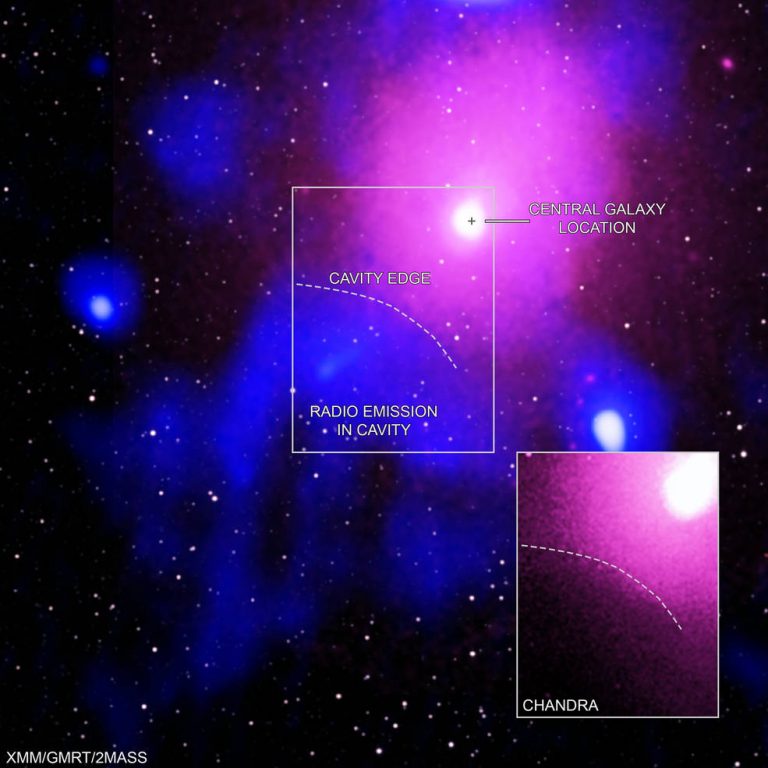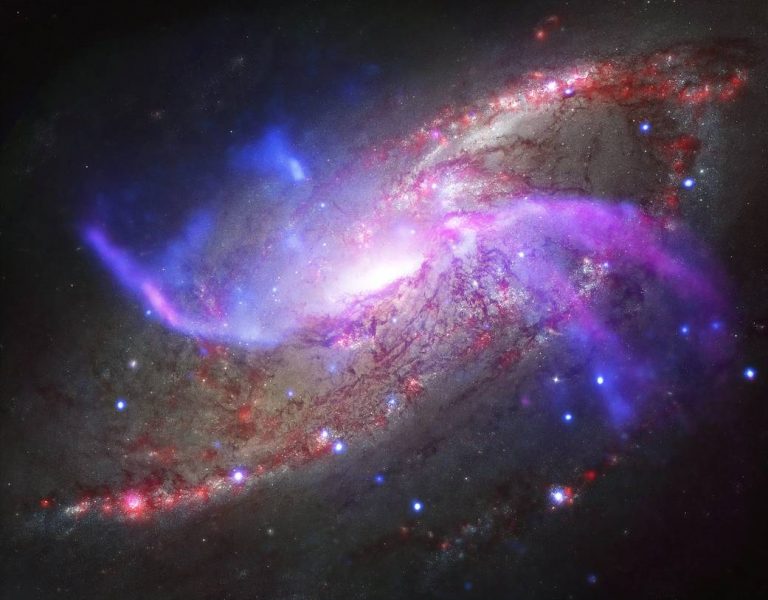跨星系的类星体海啸
一个天文学家小组利用美国国家航空航天局(NASA)的哈勃太空望远镜(Hubble Space Telescope)的独特功能,发现了宇宙中有史以来最强劲的能量外流。它们从类星体发出,像海啸一样横扫星际空间,对类星体所在的星系造成严重破坏。 类星体是极遥远的天体,释放出异常巨大的能量。类星体中包含着由入射物质推动的超大质量黑洞,这些物质的亮度是由几千亿颗恒星组成的主星系的1000倍。 当黑洞吞噬物质时,热气体将其包围并发出强烈的辐射,从而形成类星体。由黑洞附近的炽热辐射压力驱动的风将物质推离银河系的中心。这些流出物加速到惊人的速度,其速度达到光速的百分之几。 “没有其他现象会携带更多的机械能。在一千万年的生命周期中,这些流出物所产生的能量是伽马射线爆发的一百万倍。”弗吉尼亚州布莱克斯堡的弗吉尼亚理工学院的首席研究员纳胡姆·阿拉夫解释说,“这些风每年都在推动数百个太阳质量的物质。这些流出物携带的机械能比整个银河系的光度高数百倍。” 这是一个以活跃类星体为中心的遥远星系的图示。 一个类星体会释放超高质量的黑洞,该黑洞由物质坠落推动而产生大量能量。 利用哈勃太空望远镜的独特功能,天文学家发现黑洞附近的巨大辐射压力将物质以光速的几分之一将物质推离星系中心。每年“类星体风”正在推动数百个太阳质量的物质。 当物质像雪一样进入周围的气体和尘埃中时,这会影响整个星系。 来源:NASA, ESA and J. Olmsted (STScI) 类星体风扫过星系的圆盘。原本会形成新恒星的物质被猛烈地从星系中扫出,导致恒星的诞生停止。辐射将气体和尘埃推到远比科学家先前认为的更远的地方,形成了整个星系范围的事件。 当宇宙海啸猛烈撞击星际物质时,激波前部的温度会飙升到数十亿度,在那里物质在X射线中大量发光,但在整个光谱中也很宽泛。任何目睹这一事件的人都会看到灿烂的天象。“你首先会受到x射线和伽玛射线的大量辐射,然后它会渗透到可见光和红外光中。”阿拉夫说,“你会看到一个巨大的像灯光秀一样的圣诞树遍布整个星系。” 星系演化的数值模拟表明,这种外流现象可以解释一些重要的宇宙学难题,例如,为什么天文学家在宇宙中观察到的大星系如此之少,以及为什么星系的质量与其中心黑洞的质量之间存在关系。这项研究表明,如此强大的类星体外流应该在早期宇宙中普遍存在。 “几十年来,理论家和观测者都知道,在大质量星系中,有一些物理过程阻止了恒星的形成,但这个过程的本质一直是个谜。”纽约哥伦比亚大学和新泽西州普林斯顿大学的著名宇宙学家耶利米·P·奥萨斯特解释说,“将观测到的流出物纳入我们的模拟可以解决银河系进化中的这些突出问题。” 天文学家研究了13个类星体的外流,他们通过观察这些发光的气体发出的光谱“指纹”,可以计算出类星体风加速气体的惊人速度。哈勃的紫外线数据显示,由于气体在空间中的快速运动,由物质沿光路产生的这些光吸收特征在光谱中发生了位移。这是由于多普勒效应所致,一个物体的运动压缩或拉伸光波,取决于它是接近还是远离我们。只有哈勃望远镜具有特定的紫外线敏感度范围,天文学家才能获得导致这一发现的必要观测结果。 除了测量迄今为止观测到的能量最大的类星体外,研究小组还发现了另一个比其他任何类星体都要快的星体流出物。在三年的时间里,它从4300万英里每小时加速到大约4600万英里每小时。科学家们认为,随着时间的推移,其加速度将继续增加。 “哈勃望远镜的紫外线观测使我们能够跟踪类星体的整个能量输出范围,从较冷的气体到更大质量的风中极热的、高度电离的气体,”马里兰州巴尔的摩太空望远镜科学研究所的研究小组成员杰拉德·克里斯s补充说。“这些以前只能通过更困难的X射线观测才能看到。如此强大的外流可能会让我们对中央超大质量黑洞的形成和整个主星系的发展之间的联系有新的认识。” 该团队还包括来自弗吉尼亚理工大学的研究生徐欣凤和博士后研究员蒂莫西·米勒,以及太空望远镜科学研究所的雷切尔·普莱莎。这些发现在2020年3月发表在《天体物理学杂志增刊》重点期刊的一系列的六篇论文中。 哈勃太空望远镜是NASA与ESA(欧洲航天局)之间国际合作的项目。位于马里兰州格林贝尔特的NASA戈达德太空飞行中心负责管理该望远镜。太空望远镜科学研究所(STScI)进行哈勃科学操作。 STScI由位于华盛顿特区的天文学研究大学协会为NASA运营。 来源: https://www.nasa.gov/feature/goddard/2020/quasar-tsunamis-rip-across-galaxies










